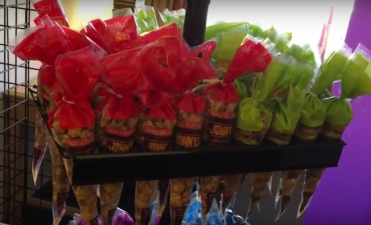Salty Snack Sales Sweeten With Healthier, Alternative Ingredients 1/26/2017
In ECRM's past two insights articles based on attendee interviews from last year's Natural, Organic & Specialty Food EPPS and Foodservice: Natural, Organic & Better for You, we discussed how healthier ingredients are making their wey into foods throughout retail food stores and foodservice operations -- including more plant-based proteins, and even cricket proteins (which I taste-tested in this video).
The snack category is also undergoing this change, and has benefited from the influx of healthier formulations that better fit the nutrition-centered lifestyles of many of today's consumers. This push towards healthier snacks has created a thriving market for alternative ingredient snacks made using pulses and alternative vegetables and grains such as chickpeas, sweet potatoes, kale, and spinach, among other novel elements.
Indeed, sales of alternative ingredients snacks in 2017 are forecast to rise to $1.2 billion, according to market research firm Packaged Facts in the brand new report Snack Food Nutrition Trends: Pulses, Vegetables, and Grains in Salty Snacks and Crackers. (In fact, Packaged Facts Research Director David Sprinkle spoke on the topic of healthy foodservice at ECRM's Foodservice: Natural, Organic & Better for You EPPS.)
"Looking at both present trends and towards the future, alternative ingredient snack sales are going to continue moderate to strong growth over the next few years, building on the larger healthier-for-you trend affecting the overall snack market and on the unique flavors and textures consumers are also craving," says Sprinkle.
The strong growth of sales of alternative vegetable-based snacks, particularly salty snack versions, was the largest factor contributing to the rise in sales in 2016. Packaged Facts estimates the salty snack segment carried the alternative-ingredient snack market in 2016, with growth of almost 7%, or faster growth than what was seen by salty snacks as a whole.
From 2006 to 2016, the percentage of all adults who usually only snack on healthy foods grew from 24% to 30%. Beyond the general uptick in healthy eating, the most important market drivers are demographic and have to do with age, specifically families with children and snackers making up the younger generational cohorts. For any given category of snack, the percentage of adults with children in the household who eat the snack is 19% or more than the percentage of adults who eat the snack and who do not have any children in the household.
While young families with children are extremely important for the alternative-ingredient snack market, it is fair to say that all younger people are an important demographic driver. There is a very large gap in the percentage of Millennials and Gen X adults who eat these snacks compared to those who are 50 and older. This type of snack, almost more than any other, appeals to younger people. While novelty is certainly a factor with Millennials, typically the reasons for why a person chooses alternative-ingredient snacks are essentially the same across all age groups; the number of those who are 50 or younger who choose to do so is simply much greater.
As with young families, the potential of theses younger cohorts as a driver for the alternative-ingredient snack market is only going to increase with time as they become a greater percentage of the population and gain additional buying power. The interesting question is whether those who are just becoming adults now (i.e., Gen Z) will follow in the footsteps of their (slightly older) elders or forge a new snacking path.
About the Report
Snack Food Nutrition Trends: Pulses, Vegetables, and Grains in Salty Snacks and Crackers provides an in depth analysis of alternative ingredient snack products and sales through all channels in the U.S. market, focusing on the key categories of snacks driving the market and highlighting sales trends.
The report covers sales of salty snacks and crackers containing pulses such as beans, chickpeas, lentils, and peas, vegetables such as sweet potato, spinach, and kale, and notable grain ingredient formulations such as whole grain, multigrain, and ancient grains. All information and analyses in the report is highly accessible, presented in concise text and easy-to-read and practical charts, tables, and graphs.
About Packaged Facts
Rockville, Md.-based Packaged Facts, a division of MarketResearch.com, publishes market intelligence on a wide range of consumer market topics, including consumer demographics and shopper insights, consumer financial products and services, consumer goods and retailing, consumer packaged goods, and pet products and services.

